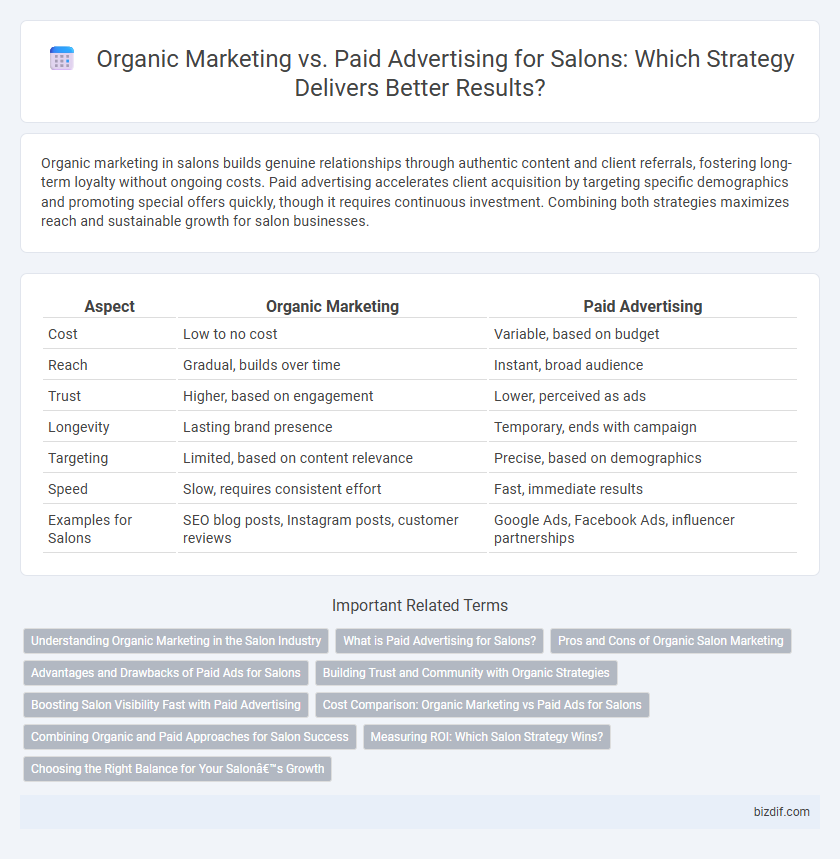Organic marketing in salons builds genuine relationships through authentic content and client referrals, fostering long-term loyalty without ongoing costs. Paid advertising accelerates client acquisition by targeting specific demographics and promoting special offers quickly, though it requires continuous investment. Combining both strategies maximizes reach and sustainable growth for salon businesses.
Table of Comparison
| Aspect | Organic Marketing | Paid Advertising |
|---|---|---|
| Cost | Low to no cost | Variable, based on budget |
| Reach | Gradual, builds over time | Instant, broad audience |
| Trust | Higher, based on engagement | Lower, perceived as ads |
| Longevity | Lasting brand presence | Temporary, ends with campaign |
| Targeting | Limited, based on content relevance | Precise, based on demographics |
| Speed | Slow, requires consistent effort | Fast, immediate results |
| Examples for Salons | SEO blog posts, Instagram posts, customer reviews | Google Ads, Facebook Ads, influencer partnerships |
Understanding Organic Marketing in the Salon Industry
Organic marketing in the salon industry revolves around building genuine client relationships through content marketing, social media engagement, and local SEO strategies that highlight unique services and client testimonials. This approach enhances brand trust and loyalty by showcasing real results and expert advice without direct advertising costs. Leveraging organic marketing efforts increases long-term clientele retention and natural referrals essential for sustainable salon growth.
What is Paid Advertising for Salons?
Paid advertising for salons involves investing in targeted ads on platforms like Facebook, Instagram, and Google to attract new clients quickly. This strategy uses demographic data, geographic location, and user behavior to optimize visibility and increase appointment bookings. Compared to organic marketing, paid advertising delivers faster, measurable results by directly promoting services such as haircuts, coloring, and spa treatments.
Pros and Cons of Organic Salon Marketing
Organic salon marketing builds authentic client relationships through social media engagement, positive reviews, and local collaborations, fostering long-term loyalty without direct advertising costs. It requires consistent effort and time to see measurable growth, limiting immediate reach compared to paid advertising campaigns that deliver faster results. However, organic strategies enhance brand credibility and trust, which are crucial for sustained salon growth in competitive markets.
Advantages and Drawbacks of Paid Ads for Salons
Paid advertising for salons offers immediate visibility and targeted reach through platforms like Facebook and Google Ads, enabling precise audience segmentation based on demographics and interests. However, the high cost per click and ongoing expenditure can strain salon budgets, especially for small businesses, while results may diminish once the ad spend stops. Furthermore, paid ads often require continuous optimization and expert management to maintain effectiveness and return on investment in a competitive beauty industry market.
Building Trust and Community with Organic Strategies
Organic marketing in salons fosters genuine relationships by engaging clients through authentic content and personalized interactions, enhancing brand loyalty and trust. Leveraging social media platforms and community events cultivates a sense of belonging that paid advertising often cannot replicate. Consistent organic efforts create a sustainable client base by emphasizing real experiences and word-of-mouth referrals over transactional outreach.
Boosting Salon Visibility Fast with Paid Advertising
Paid advertising accelerates salon visibility by targeting specific demographics through platforms like Facebook Ads and Google Ads, delivering immediate traffic and bookings. Organic marketing builds long-term brand trust via SEO, social media engagement, and content creation but requires more time to yield results. For salons aiming to boost foot traffic rapidly, paid campaigns offer measurable ROI and swift client acquisition compared to the gradual growth of organic strategies.
Cost Comparison: Organic Marketing vs Paid Ads for Salons
Organic marketing for salons primarily relies on content creation, social media engagement, and word-of-mouth referrals, resulting in lower upfront costs but requiring significant time investment. Paid advertising, such as Google Ads or Facebook promotions, involves direct expenses that can quickly scale based on budget but offers immediate visibility and targeted reach. Comparing costs, organic efforts reduce financial outlays but grow gradually, while paid ads demand continuous expenditure for sustained client acquisition.
Combining Organic and Paid Approaches for Salon Success
Combining organic marketing and paid advertising boosts salon success by maximizing reach and client engagement. Organic strategies like SEO-optimized content, social media presence, and client reviews build trust and brand loyalty, while paid ads target specific demographics and drive immediate bookings. This integrated approach enhances visibility, fosters community, and accelerates revenue growth.
Measuring ROI: Which Salon Strategy Wins?
Measuring ROI in salon marketing reveals that organic strategies often yield higher long-term value through customer loyalty and sustained engagement, while paid advertising delivers immediate traffic spikes and measurable short-term returns. Tracking metrics like client retention, social media engagement, and repeat bookings provides insight into the lifetime value generated by organic marketing. In contrast, paid ads require monitoring cost per acquisition and conversion rates to assess profitability and overall campaign effectiveness.
Choosing the Right Balance for Your Salon’s Growth
Organic marketing builds long-term trust and engagement for salons through social media content, client reviews, and SEO-focused blogs, while paid advertising drives immediate bookings via targeted ads on platforms like Instagram and Google. A balanced approach leverages organic efforts to cultivate loyal clientele and brand authority, complemented by paid campaigns that boost visibility and attract new customers during promotions or seasonal peaks. Monitoring key performance indicators such as customer acquisition cost and return on ad spend helps salons optimize this balance for sustained growth.
Organic marketing vs Paid advertising Infographic

 bizdif.com
bizdif.com